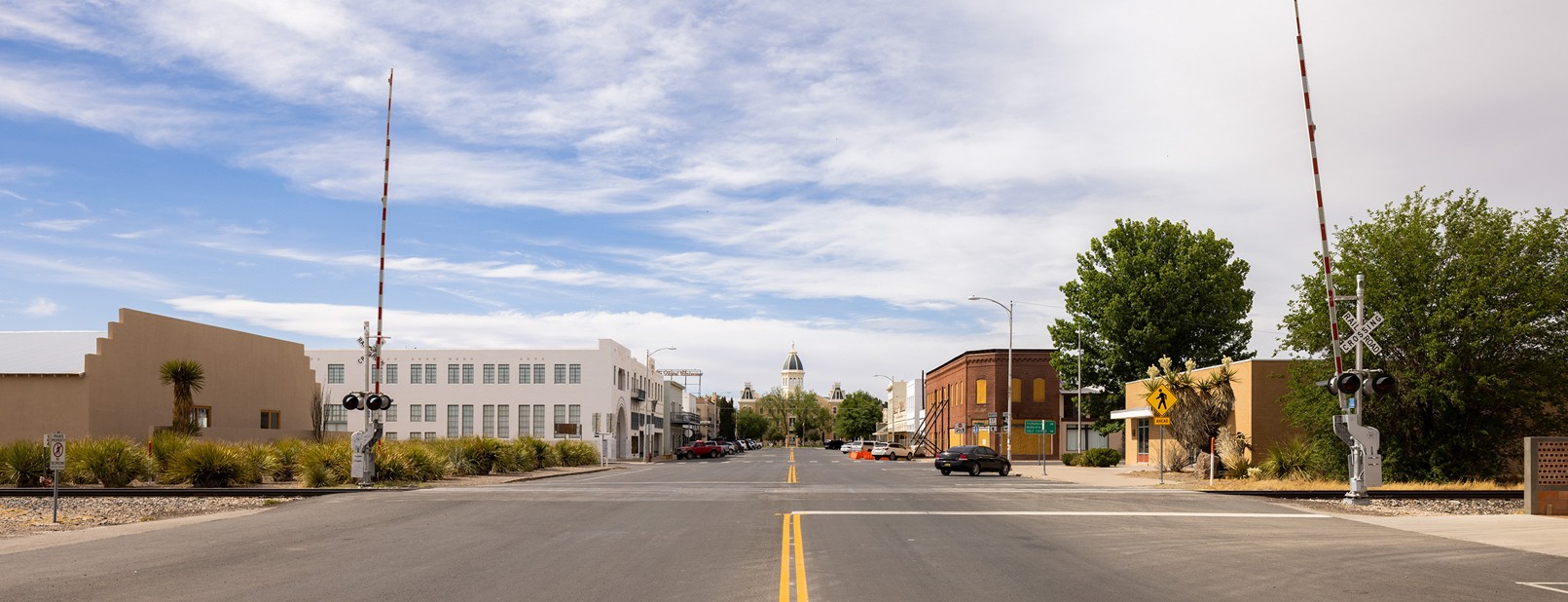

The Central Marfa Historic District, including eleven buildings preserved and repurposed by the artist Donald Judd, has been listed on the National Register of Historic Places. The listing is the first time that Judd’s approach to architecture and preservation has been recognized as historically significant at the federal level.
This addition to the National Register acknowledges the historical, architectural, and cultural significance of the City of Marfa, the importance of the town’s Hispanic heritage, and its growth as a mercantile center from the late nineteenth century into the postwar period. The district’s listing further recognizes eleven buildings Judd acquired and adapted between 1973 and 1994. These buildings are today maintained by Judd Foundation and the Chinati Foundation.
“Through this designation, granted to the town of Marfa and Don’s buildings, we join a meaningful list of historic sites in the United States,” says Rainer Judd, president of Judd Foundation. “Don had a profound regard and deep respect for the history and contributions of the Hispanic community that this nomination specifically recognizes. He believed that these efforts, reflected in the built environment of the town, should be preserved and celebrated. This national honor for Marfa is important to understanding our shared past and preserving these buildings for future generations.”
“The Chinati Foundation is deeply honored for our buildings in downtown Marfa to be worthy of such recognition by the National Park Service. Being added to the National Register of Historic Places will help build community pride and amplify our sense of place,” says Chinati Foundation director Jenny Moore. “We are proud of our Marfa neighbors with whom we share this distinction, and we look forward to working together in the restoration and preservation of our unique town.”
The buildings associated with Judd, which span multiple typologies and use, are highly visible elements of the city’s commercial roots in the late nineteenth and early twentieth centuries. Judd largely preserved the overall configurations of the buildings and repurposed them in ways cognizant of their respective scale and architectural qualities. His considered adaptations were central to his own artistic production and the long-term installation of his work and that of fellow artists, as well his belief in the importance of preservation. Maintained and made publicly accessible by the Chinati Foundation and Judd Foundation, they are places in which visitors can study Judd’s art and architecture and recognize the importance of preserving historic buildings.
The Central Marfa Historic District comprises 183 contributing buildings and architectural resources centered on Marfa’s principal commercial street, Highland Avenue. The district builds on the current historic designations for Fort D.A. Russell, a military base that was active until shortly after World War II, and that of the Blackwell School, the only public institution built for the education of the Mexican American community of Marfa, which it served for more than fifty years.
“This National Register listing required hard work and cooperation between many persons and organizations over several years,” says Gregory Smith of the Texas Historical Commission. “The nomination tells a complex story, from the city’s founding along the railroad, its settlement and growth through the first half of the twentieth century, and its more recent history that led to its recognition as an essential place to experience modern art. This nomination is distinct from most National Register listings that focus on local history that occurred more than fifty years prior as it expands on those stories to also recognize the significance of Donald Judd and his exceptional contributions.”
Of the eleven buildings purchased and adapted by Judd, eight are maintained today by Judd Foundation and three by the Chinati Foundation. Under Judd Foundation’s stewardship are the Architecture Office, Architecture Studio, Art Studio, Cobb House, Gatehouse, Ranch Office, Print Building, and Whyte Building. The Chinati Foundation oversees the Chamberlain Building, Ice Plant, and Locker Plant.
The Central Marfa Historic District was recommended for listing in the National Register of Historic Places by the Texas Historical Commission in December 2021. It was added to the National Register in April 2022 by the National Park Service.
About Judd Foundation
Judd Foundation is a tax-exempt 501(c)(3) not-for-profit organization created to preserve Donald Judd’s permanently installed living and working spaces, libraries, and archives in New York and Marfa, Texas. The Foundation promotes a wider understanding of Judd’s artistic legacy by providing access to these spaces and resources and by developing scholarly and educational programs.
More information about Judd Foundation can be found at juddfoundation.org.
About the Chinati Foundation
The Chinati Foundation/La Fundación Chinati is a museum created by the artist Donald Judd in Marfa, Texas. The specific intention of Chinati is to preserve and present to the public permanent, large-scale installations by a select group of artists, in which the art, the architecture, and the land are inextricably linked. Artists in the collection include Donald Judd, along with Carl Andre, Ingólfur Arnarsson, John Chamberlain, Dan Flavin, Roni Horn, Robert Irwin, Ilya Kabakov, Richard Long, Claes Oldenburg and Coosje van Bruggen, David Rabinowitch, and John Wesley. Public tours and viewing of the collection, the conservation of artworks, education programs, artists’ residencies, special exhibitions, lectures, performances, and publications are all vital facets of Chinati’s mission.
More information about the Chinati Foundation can be found at chinati.org.